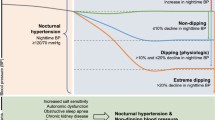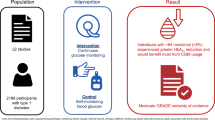Abstract
Introduction
Automated office blood pressure (AOBP) has been proposed for blood pressure (BP) assessment in the office because it shows a strong association with the awake ambulatory BP. However, it remains unknown whether the presence or absence of an observer modulates AOBP readings.
Aim
To determine the difference between unattended and attended AOBP measurements through systematic review and meta-analysis.
Methods
We searched the PubMed and the Cochrane Collaboration Library and we screened the references’ list of relevant reports to identify potentially eligible articles. For included studies, quality was assessed by using the Quality Assessment for Diagnostic Accuracy Studies 2. The weighted pooled BP difference with 95% confidence interval (CI) between unattended and attended AOBP was estimated under the random effects model.
Results
Twelve studies (1762 subjects) were included. The systolic and diastolic BP difference between unattended and attended AOBP measurements was − 3.66 (− 6.58 to − 0.75) and − 1.67 (− 2.78 to − 0.55) mmHg, respectively. Heterogeneity across studies was high (I2 = 97,1% for systolic and I2 = 89% for diastolic BP, P < 0.001) and was partially determined by the sequence of performing unattended and attended BP measurements, the device used for AOBP, the geographic region in which studies were performed and the presence of a resting period before unattended AOBP.
Conclusions
Due to the high heterogeneity, we cannot rely on the weighted pooled estimate. However, the available evidence suggests that attended AOBP yielded higher systolic and diastolic BP levels and it seems that the procedural methodology determines partially the statistical heterogeneity across studies.


Similar content being viewed by others
References
Myers MG. A short history of automated office blood pressure—15 years to SPRINT. J Clin Hypertens. 2016;18:721–4.
Myers MG, Meglis G, Polemidiotis G. The impact of physician versus automated blood pressure readings on office-induced hypertension. J Hum Hypertens. 1997;11:491–3.
Jegatheswaran J, Ruzicka M, Hiremath S, Cedric Edwards C. Are automated blood pressure monitors comparable to ambulatory blood pressure monitors? A systematic review and meta-analysis. Can J Cardiol. 2017;33:644–52.
Mattu GS, Perry TL Jr, Wright JM. Comparison of the oscillometric blood pressure monitoring (BPM-100Beta) with the auscultatory mercury sphygmomanometer. Blood Press Monit. 2001;6:153–9.
White WG, Anwar YA. Evaluation of the overall efficacy of the OMRON office digital blood pressure HEM-907 monitor in adults. Blood Press Monit. 2001;6:107–10.
Andreadis EA, Agaliotis GD, Angelopoulos ET, Tsakanikas AP, Chaveles IA, Mousoulis GP. Automated office blood pressure and 24-h ambulatory measurements are equally associated with left ventricular mass index. Am J Hypertens. 2011;24:661–6.
Andreadis EA, Agaliotis GD, Angelopoulos ET, Tsakanikas AP, Kolyvas GN, Mousoulis GP. Automated office blood pressure is associated with urine albumin excretion in hypertensive subjects Am J Hypertens. 2012;25:969–73.
The SPRINT Research Group. A randomized trial of intensive versus standard blood pressure control. N Engl J Med. 2015;373:2013–116.
Johnson KC, Whelton PK, Cushman WC, Cutler JA, Evans GW, Snyder JK. Blood pressure measurements in the Systolic Blood Pressure Intervention Trial (SPRINT). http://abstractsonline.com/pp8/4412/presentation/52757. Accessed 13 Nov 2017.
Stroup DF, Berlin JA, Morton SC, Olkin I, Williamson GD, Rennie D, et al. Meta-analysis of observational studies in epidemiology: a proposal for reporting. Meta-analysis Of Observational Studies in Epidemiology (MOOSE) group. JAMA. 2000;283(15):2008–12.
Whiting PF, Rutjes AW, Westwood ME, Mallett S, Deeks JJ, Reitsma JB, QUADAS-2 Group, et al. QUADAS-2: a revised tool for the quality assessment of diagnostic accuracy studies. Ann Intern Med. 2011;155:529–36. https://doi.org/10.7326/0003-4819-155-8-201110180-00009.
Wade R, Corbett M, Eastwood A. Quality assessment of comparative diagnostic accuracy studies: our experience using a modified version of the QUADAS-2 tool. Res Synth Methods. 2013;4:280–6.
Al-Karkhi I, Al-Rubaiy R, Rosenqvist U, Falk M, Nystrom FH. Comparisons of automated blood pressures in a primary health care setting with self-measurements at the office and at home using the Omron i-C10 device. Blood Press Monit. 2015;20:98–103. https://doi.org/10.1097/MBP.0000000000000088.
Andreadis EA, Geladari CV, Angelopoulos ET, Savva FS, Georgantoni AI, Papademetriou V. Attended and unattended automated office blood pressure measurements have better agreement with ambulatory monitoring than conventional office readings. J Am Heart Assoc. 2018;7:e008994. https://doi.org/10.1161/JAHA.118.008994.
Bauer F, Seibert FS, Rohn B, Bauer KAR, Rolshoven E, Babel N, et al. Attended versus unattended blood pressure measurements in a real life setting. Hypertension. 2018;71:243–9. https://doi.org/10.1161/HYPERTENSIONAHA.117.10026.
Greiver M, David White D, Kaplan DM, Katz K, Moineddin R, Dolabchian E. Where should automated blood pressure measurements be taken? Pilot RCT of BpTRU measurements taken in private or nonprivate areas of a primary care office. Blood Press Monit. 2012;17:137–8.
Hong D, Su H, Li J, Xu J, Peng Q, Yang Q, et al. The effect of physician presence on blood pressure. Blood Press Monit. 2012;17:145–8.
Papademetriou V, Tsioufis C, Chung A, Geladari C, Andreadis EA. Unobserved automated office BP is similar to other clinic BP measurements: a prospective randomized study. J Clin Hypertens. 2018;10:1411–6.
Rinfret F, Cloutier L, Wistaff R, Birnbaum LM, Ng Cheong N, Laskine M, et al. Comparison of different automated office blood pressure measurement devices: evidence of nonequivalence and clinical implications. Can J Cardiol. 2017;33:1639–44. https://doi.org/10.1016/j.cjca.2017.09.011.
Stergiou GS, Efstathiou SP, Alamara CV, Mastorantonakis SE, Roussias LG. Home or self-blood pressure measurement? What is the correct term? J Hypertens. 2003;21:2259–64.
Polonia J, Rouxinol-Dias A, Araujo S, Silva J, Barbosa L. Association between ambulatory blood pressure values and central aortic pressure in large population of normotensive and hypertensive subjects. J Hypertens. 2017;35:e218.
Martin CA, Cameron JD, Chen SS, McGrath BP. Two hour glucose post loading: a biomarker of cardiovascular risk in isolated clinic hypertension. J Hypertens. 2011;29:749–57. https://doi.org/10.1097/HJH.0b013e328342eeeb.
Siddiqui M, Judd EK, Oparil S, Calhoun DA. White-coat effect is uncommon in patients with refractory hypertension. Hypertension. 2017;70:645–51. https://doi.org/10.1161/HYPERTENSIONAHA.117.09464.
Paini A, Bertacchini F, Stassaldi D, Aggiusti C, Maruelli G, Arnoldi C, et al. Unattended versus attended blood pressure measurement: Mean values and determinants of the difference. Int J Cardiol. 2018. https://doi.org/10.1016/j.ijcard.2018.06.056 (Epub ahead of print).
Stergiou G, Kollias A, Parati G, O’Brien E. Office blood pressure measurement. The weak cornerstone of hypertension diagnosis. Hypertension. 2018;71:813–5.
Salvetti M, Paini A, Bertacchini F, Stassaldi D, Maruelli G, Cappellini S, et al. Relationship between unattended and attended BP values and preclinical organ damage. J Hypertens. 2018;36:e112. https://doi.org/10.1097/01.hjh.0000539295.55926.
Acknowledgements
The corresponding author (E. A.) is responsible for the design of the study, the preparation of the first draft and the completion of the whole manuscript C. T. and C. G. have done the systematic review of the literature and extracted data. C. T. has conducted the meta-analysis. All four authors have substantially contributed to interpretation of data, critical revision of the article for important intellectual content and given final approval of the version to be published. We would like also to cordially thank Dr. Polonia and Dr. Martin for their valuable help in providing additional information of their studies.
Author information
Authors and Affiliations
Corresponding author
Ethics declarations
Funding
We received no funding for this work.
Conflict of interest
CT declares consultancy fees from Astra Zeneca, Menarini and lecture honoraria from Sanofi, MSD, Menarini and Servier. The other authors declare no conflict of interest regarding this review and meta-analysis.
Ethical approval
This article does not contain any studies with human participants or animals performed by any of the authors.
Electronic supplementary material
Below is the link to the electronic supplementary material.
Rights and permissions
About this article
Cite this article
Andreadis, E.A., Thomopoulos, C., Geladari, C.V. et al. Attended Versus Unattended Automated Office Blood Pressure: A Systematic Review and Meta-analysis. High Blood Press Cardiovasc Prev 26, 293–303 (2019). https://doi.org/10.1007/s40292-019-00329-1
Received:
Accepted:
Published:
Issue Date:
DOI: https://doi.org/10.1007/s40292-019-00329-1




